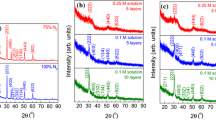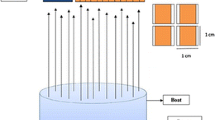Abstract
An introduction to the wet-chemical processing of indium tin oxide (ITO), aluminium-doped zinc oxide (AZO) and antimony-doped tin oxide (ATO) thin films is given, their performance is compared to materials derived from physical and chemical vapour deposition. Strategies to reduce inherent limitations of sol–gel coatings due to residual porosity are emphasized. Printability as a specific advantage of solution-based techniques is highlighted. It also is shown how compositional flexibility and the facile introduction of dopants are used to explore the potential of novel p-type conductive delafossites.
Access this chapter
Tax calculation will be finalised at checkout
Purchases are for personal use only
Similar content being viewed by others
References
Chopra K, Major S, Padya D (1982) Transparent conductors – A status review. Thin Solid Films 102:1
Gosh PK, Das S, Kundoo S, Chattopadhyay K (2005) Effect of fluorine doping on semiconductor to metal-like transition and optical properties of cadmium oxide thin films deposited by sol–gel process. J Sol-Gel Sci Technol 34:173
Granqvist C (2007) Transparent conductors as solar energy materials. A panoramic review. Sol Energ Mater Sol Cells 91:1529
Henery V. Chemical vapor deposition of tin oxide on float glass in the tin bath. US Patent 4853257
Szanyi J (2002) The origin of haze in CVD tin oxide thin films. Appl Surf Sci 185:161
Szyszka B (2001) Transparente und leitfähige Oxidschichten. Vakuum in Forschung und Praxis 1:38
Sawada Y, Kobayashi C, Seki S, Funakubo H (2002) Highly-conducting indium–tin-oxide transparent films fabricated by spray CVD using ethanol solution of indium (III) chloride and tin (II) chloride. Thin Solid Films 409:46
Suzuki A, Matsushita T, Aoki T, Mori A, Okuda M (2002) Highly conducting transparent indium tin oxide films prepared by pulsed laser deposition. Thin Solid Films 411:23
Biswas P, De A, Ortner K, Korder S (2004) Study of sol–gel-derived high tin content indium tin oxide (ITO) films on silica-coated soda lime silica glass. Mater Lett 58:1540
Hammad T (2006) ITO Thin films on silicon buffer by sol–gel method. Mat Sci Forum 514–516:1155
Minami T, Oohashi K, Takata S, Mouri T, Ogawa N (1990) Preparations of ZnO:Al transparent conducting films by D.C. magnetron sputtering. Thin Solid Films 193/194:721
Agura H, Suzuki A, Matsushita T, Akoi T, Okuda M (2003) Low resistivity transparent conducting Al-doped ZnO films prepared by pulsed laser deposition. Thin Solid Films 445:263
Schuler T, Aegerter M (1999) Optical, electrical and structural properties of sol–gel ZnO:Al coatings. Thin Solid Films 351:125
Lin K, Tsai P (2007) Growth mechanism and characterization of ZnO: Al multi-layered thin films by sol–gel technique. Thin Solid Films 515:8610
Sobajima Y, Kato S, Matsuura T, Toyama T, Okamoto H (2007) Study of the light-trapping effects of textured ZnO:Al/glass structure TCO for improving photocurrent of a-Si:H solar cells. J Mater Sci Mater Electron 18:S159
Szyszka B, Löbmann P, Georg A, May C, Elsaesser C (2010) Development of new transparent conductors and device applications utilizing a multidisciplinary approach. Thin Solid Films 518:3109
Jäger S, Szyszka B, Szczyrbowski J, Bräuer G (1998) Comparison of transparent conductive oxide thin films prepared by A.C. and D.C. reactive magnetron sputtering. Surf Coat Technol 98:1304
Lee S, Hong B, Choi WS (2009) Structural, electrical and optical properties of antimony-dopded tinoxide films prepared at room temperature by radio frequency. J Vac Sci Technol A 27:996–1000
Dua L, De A, Chakraborty S, Biswas P (2008) Study of spin coated high antimony content Sn–Sb oxide films on silica glass. Mater Charact 59:578
Benrabah B, Bouaza A, Hamzaoui S, Dehbi A (2009) Sol–gel preparation and characterization of antimony doped tin oxide (ATO) powders and thin films. Eur Phys J Appl Phys 48:30301
Ma H, Zhang D, Win S, Li S, Chen Y (1996) Electrical and optical properties of F-doped textured SnO2 films deposited by APCVD. Sol Energ Mater Sol Cells 40:371
Talaty N, Beck K, Citeau H, Kirschbaum K, Giolando D (2009) Characterization of Tin(IV) oxide thin films prepared by atmospheric pressure chemical vapor deposition of cis-[SnCl4{OC(H)OC2H5}2]. Z Anorg Allg Chem 635:53
Lin C, Chiang M, Chen Y (2009) Temperature dependence of fluorine-doped tin oxide films produced by ultrasonic spray pyrolysis. Thin Solid Films 518:1241
Liu J, Rädlein E, Frischat G (1999) Preparation, nanostructure and properties of indium tin oxide (ITO) films on glass substrates. Part 2. Optimisation of properties. Phys Chem Glasses 40:282
Savarimuthu E, Lalithambika K, Raj A, Nehru LC, Ramamurthy S, Thayumanavan A, Sanjeeviraja C, Jayachandran M (2007) Synthesis and materials properties of transparent conducting In2O3 films prepared by sol–gel-spin coating technique. J Phys Chem Solids 68:1380
Beaurain A, Luxembourg D, Dufour C, Koncar V, Capoen B, Bouazaoui M (2008) Effects of annealing temperature and heat-treatment duration on electrical properties of sol–gel derived indium-tin-oxide thin films. Thin Solid Films 516:4102
Su C, Sheu T, Chang Y, Wan M, Feng M, Hung W (2005) Preparation of ITO thin films by Sol–gel process and their characterizations. Synt Met 153:9
Li Z, Ren D (2006) Preparation of ITO transparent conductive film by sol–gel method. Trans Nonferrous Met Soc China 16:1358
Al-Dahoudi N, Aegerter M (2006) Comparative study of transparent conductive In2O3:Sn(ITO) coatings made using a sol and a nanoparticle suspension. Thin Solid Films 502:193
Biswas P, Dea A, Dua L, Chkoda L (2006) Work function of sol–gel indium tin oxide (ITO) films on glass. Appl Surf Sci 253:1953
Aksu Y, Driess M (2009) A low-temperature molecular approach to highly conductive tin-rich indium tin oxide thin films with durable electro-optical performance. Angew Chem 121:7918
Alam M, Cameron D (2001) Characterization of transparent conductive ITO thin films deposited on titanium dioxide film by a sol–gel process. Surf Coat Technol 142–144:776
Alam M, Cameron D (2002) Investigation of annealing effects on sol–gel deposited indium tin oxide thin films in different atmospheres. Thin Solid Films 420–421:76
Löbmann P, Röhlen P (2003) Industrial processing of TiO2 thin films from soluble precursor powders. J Glass Sci Technol 76:1
Cho Y, Kim H, Hong J, Yi G, Yang S, Yang S (2009) Dispersion stabilization of conductive transparent oxide nanoparticles. Coll and Surf A 336:88
Goebbert C, Nonninger R, Aegerter M, Schmidt H (1999) Wet chemical deposition of ATO and ITO coatings using crystalline nanoparticles redispersable in solutions. Thin Solid Films 351:79
Aegerter M, Al-Dahoudi N (2003) Wet-chemical processing of transparent and antiglare conducting ITO coating on plastic substrates. J Sol-Gel Sci Technol 27:81
Ederth J, Johnson P, Niklasson G, Hoel A, Hultaker A, Heszler P, Granqvist C, van Doorn A, Jongerius M, Burgard D (2003) Electrical and optical properties of thin films consisting of tin-doped indium oxide nanoparticles. Phys Rev B 68:155410
Ederth J, Heszler P, Hultaker A, Niklasson G, Granqvist C (2003) Indium tin oxide films made from nanoparticles: models for the optical and electrical properties. Thin Solid Films 445:199
Natsume Y, Sakata H (2002) Electrical and optical properties of zinc oxide films post-annealed in H2 after fabrication by sol–gel process. Mat Chem Phys 78:170
Lee J, Ko K, Park B (2003) Electrical and optical properties of ZnO transparent conducting films by the sol–gel method. J Cryst Growth 247:119
Hammad T (2006) Electrical and optical properties of multilayer sol–gel ZnO coatings. Int J Modern Phys B 20:3357
Kyaw A, Sun X, Jiang C (2009) Efficient charge collection with sol–gel derived colloidal ZnO thin films in photovoltaic devices. J Sol-Gel Sci Technol 52:348
Kaur R, Singh A, Mehra R (2006) Sol–gel derived highly transparent and conducting yttrium doped ZnO films. J Non-Cryst Solids 352:2335
Schuler T, Krajewski T, Grobelsek I, Aegerter M (2006) Influence of structure zone model parameters on the electrical properties of ZnO:Al sol–gel coatings. Thin Solid Films 502:67
Kuo SY, Chen WC, Lai FI, Cheng CP, Kuo HC, Wang SC, Hsieh WF (2006) Effects of doping concentration and annealing temperature on properties of highly-oriented Al-doped ZnO films. J Crystal Growth 287:78
Lin J, Wu J (2008) The effect of annealing processes on electronic properties of sol–gel derived Al-doped ZnO films. Appl Phys Lett 92:134103
Yi SH, Choi SK, Jang JM, Kim JA (2007) Properties of aluminium doped zinc oxide thin film by sol–gel process. Proc SPIE 6831:68311A-1-8
Copuroglu M, O’Brien S, Crean GM (2009) Sol–gel synthesis, comparative characterization, and reliability analyses of undoped and Al-doped zinc oxide thin films. Thin Solid Films 517:6323–6326
Boudiar T, Sandu C, Canut B, Blanchin M, Teodorescu V, Roger J (2003) Interest of rapid thermal annealing (RTA) for the elaboration of SnO2:Sb transparent conducting oxide by the sol–gel technique. J Sol-Gel Sci Technol 26:1067
Geraldo V, Scalvi L, Morais D, Santilli C, Pulcinelli H (2003) Sb doping effects and oxygen adsorption in SnO2 thin films deposited via sol–gel. Mat Res 6:451
Puetz J, Chalvet F, Aegerter M (2003) Wet chemical deposition of transparent conducting coatings in glass tubes. Thin Solid Films 442:53
Guzman G, Dahmani B, Puetz J, Aegerter M (2006) Transparent conducting sol–gel ATO coatings for display applications by an improved dip coating technique. Thin Solid Films 502:281
Schuler T, Krajewski T, Grobelsek I, Aegerter M (2004) A microstructural zone model for the morphology of sol–gel coatings. J Sol-Gel Sci Technol 31:235
Alam M, Cameron D (2001) Preparation and properties of transparent conductive aluminum-doped zinc oxide thin films by sol–gel process. J Vac Sci Tech A 19:1642
Wang C, Meinhardt J, Löbmann P (2010) Growth mechanism of Nb-doped TiO2 sol–gel multilayer films characterized by SEM and focus/defocus TEM. J Sol-Gel Sci Technol 53:148
Furubayashi Y, Hitosugi T, Yamamoto Y, Hirose Y, Kinoda G, Inaba K, Shimada T, Hasegawa T (2006) Novel transparent conducting oxide: Anatase. Thin Solid Films 496:157
Hitosugi T, Ueda A, Furubayashi Y, Hirose Y, Konuma S, Shimada T, Hasegawa T (2007) Fabrication of TiO2-based transparent conducting oxide films on glass by pulsed laser deposition. Jpn J Appl Phys 46:86
Yamada N, Hitosugi T, Hoang N, Furubayashi Y, Hirose Y, Shimada T, Hasegawa T (2007) Fabrication of low resistivity Nb-doped TiO2 transparent conductive polycrystalline films on glass by reactive sputtering. Jpn J Appl Phys 46:5275
Prodi-Schwab A, Lüthge T, Jahn R, Herbig B, Löbmann P (2008) Modified procedure for the sol–gel processing of indium–tin oxide (ITO) films. J Sol-Gel Sci Technol 47:68
Facchetti A, Marks T (2010) Transparent electronics – From synthesis to applications. Wiley, London
Puetz J, Aegerter M (2008) Direct gravure printing of indium tin oxide nanoparticle patterns on polymer foils. Thin Solid Films 516:4495
Kawazoe H, Yasukawa M, Hyodo H, Kurita M, Yanagi H, Hosono H (1997) P-type electrical conduction in transparent thin films of CuAlO2. Nature 389:939
Ingram B, González G, Mason T, Shahriari D, Barnabè A, Ko D, Poeppelmeier K (2004) Transport and defect mechanisms in cuprous delafossites. 1. Comparison of hydrothermal and stndard solid-state synthesis in CuAlO2. Chem Mater 16:5616
Ohta H, Hosono H (2004) Transparent oxide optoelectronics. Mater Today 7:42
Tsuboi N, Takahashi Y, Kobayashi S, Shimizu H, Kato K, Kaneko F (2003) Delafossite CuAlO2 films prepared by reactive sputtering using Cu and Al targets. J Phys Chem Solids 64:1671
Lu Y, He Y, Yang B, Polity A, Volbers N, Neumann C, Hasselkamp D, Meyer B (2006) RF reactive sputter deposition and characterization of transparent CuAlO2 thin films. Phys Stat Sol (C) 3:2895
Götzendörfer S, Polenzky C, Ulrich S, Löbmann P (2009) Preparation of CuAlO2 and CuCrO2 thin films by sol–gel processing. Thin Solid Films 518:1153
Götzendörfer S, Bywalez R, Löbmann P (2009) Preparation of p-typed conducting transparent CuCrO2 and CuAl0.5Cr0.5O2 thin films by sol–gel processing. J Sol-Gel Sci Technol 52:113
Bywalez R, Götzendörfer S, Löbmann P (2010) Structural and physical effects of Mg-doping on p-type CuCrO2 and CuAl0.5Cr0.5O2 thin films. J Mater Chem 20:6562
Author information
Authors and Affiliations
Corresponding author
Editor information
Editors and Affiliations
Rights and permissions
Copyright information
© 2013 Springer-Verlag Wien
About this chapter
Cite this chapter
Löbmann, P. (2013). Transparent Conducting Oxides. In: Schneller, T., Waser, R., Kosec, M., Payne, D. (eds) Chemical Solution Deposition of Functional Oxide Thin Films. Springer, Vienna. https://doi.org/10.1007/978-3-211-99311-8_26
Download citation
DOI: https://doi.org/10.1007/978-3-211-99311-8_26
Published:
Publisher Name: Springer, Vienna
Print ISBN: 978-3-211-99310-1
Online ISBN: 978-3-211-99311-8
eBook Packages: Chemistry and Materials ScienceChemistry and Material Science (R0)




